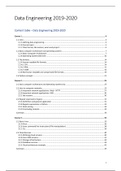Resume
Summary Data Engineering
This summary Data Engineering contains the course material with extra notes in grey and is made in the year including my answers for the example exam and example questions during the course. Also contains questions of exam itself. This document is very handy to learn in a structured way (highly st...
[Montrer plus]
Dernier document publié: 4 année de cela
Publié le
21 mai 2020
Fichier mis à jour le
15 juin 2020
Nombre de pages
190
Écrit en
2019/2020
Type
Resume
Par: arnaudalloin • 6 mois de cela
Par: jeroenvandekerckhove • 4 année de cela
S'abonner
€9,76
Garantie de satisfaction à 100%
Disponible immédiatement après paiement
En ligne et en PDF
Tu n'es attaché à rien
Data Engineering 2019-2020




